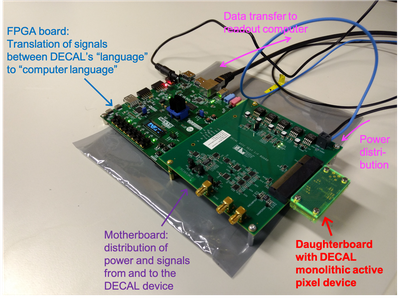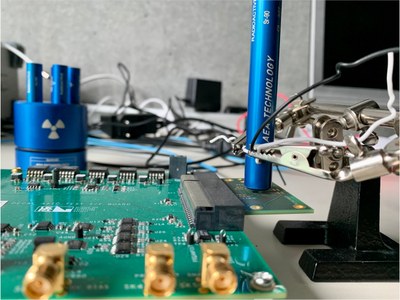Our laboratory

The test system
The workhorse in our laboratory is the test system: The DECAL sensor is mounted on a printed circuit board (PCB) which fans out all signals and power lines needed to operate the sensor and obtain its data.
This PCB is connected to a so-called motherboard, which transfers the signals from and to the DECAL sensor but also distributes the power to the various elements on the sensor.
The configuration and data readout is done by a field programmable gate array (FPGA). The FPGA can be programmed through a computer and sends the data of the DECAL sensor back to the computer. That data can then be analyzed by us physicists.

Irradiation with radioactive sources
One way to test the sensor is to irradiate them with radioactive sources. The sources at the institute, which are also used for the F-Praktikum, are beta- and gamma-ray emitters. They help us understand the performance of the DECAL sensor. One drawback of the radioactive sources is that the radioactive decay is a stochastic and thus irregular process. Also, the activity of the sources is not very high, i.e. a measurement with radioactive sources can take hours.
The picture here shows an irradiation of the DECAL sensor backside with beta particles (i.e. electrons) using a Sr-90 source.

Signals with laser illumination
The latest addition to our laboratory is a so-called TCT machine. This system can focus a pulsed laser of a specific wavelength on a single pixel of the DECAL sensor. This allows us to study every single element of the DECAL sensor with high statistics. One special test method is to inject the laser light from the side (i.e. the short edge of the sensor) so one can test the sensor’s behaviour by the depth where the signal is injected. The system has been commissioned and is ready to be used for detailed studies.
The picture shows the TCT setup for the side (edge) illumination. The system in the picture is open, i.e. not in operation as for real tests, the laser will be in a closed box with no external light.
Partner laboratories
For the DECAL project, the group of Prof. Issever at Humboldt University collaborates closely with DESY at Zeuthen and research groups in the UK. They have additional laboratory space that scientists at HU can occasionally use. In a previous master project a student went to the Rutherford Appleton Laboratory to use an X-ray machine to test the DECAL sensor.
